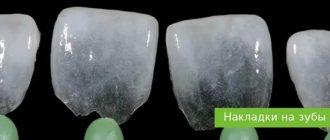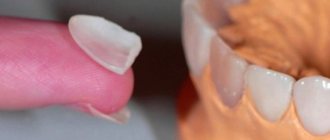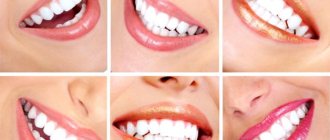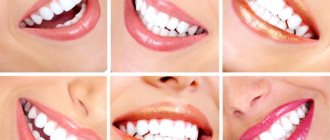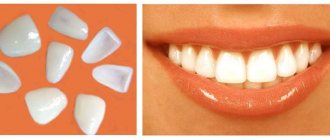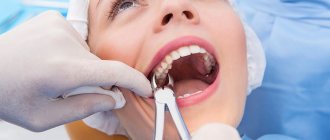Veneers What to do?
Lumineers Ultraneers Composite onlays Crowns Inlays Decorative onlays Doctors Work Dental onlays are orthopedic mini-prostheses used to restore the aesthetics of the dentition. Dental restoration is usually carried out:
- for medical reasons (treatment, prevention of dental diseases, reconstruction of lost teeth);
- in order to restore the aesthetics of a smile.
To satisfy these needs, there are many ways in which dental restoration with onlays is carried out. In this article we will look at the most popular of them.
Composite onlays for teeth
Therapeutic, or composite, onlays for teeth are used in cases where the goal is to build up a badly damaged tooth, and not just improve aesthetics. For example, they can be used in case of severe chipping of the incisor (more than half the area) or in other cases when orthopedic veneers are simply useless due to the impossibility of their installation. Such dental overlays are made using the direct method, that is, immediately on the patient’s tooth, from composite materials, hence their name – composite veneers. Therapeutic overlays have a standard color range, so in some cases the patient cannot choose the appropriate shade. The advantage of this type of onlay is that the patient receives a visible result in one visit; in addition, the price of onlays for teeth made of a composite is significantly lower than classic ceramic veneers.
Indications for use
- chips of the dental crown are less than 50% - that is, the side walls must remain so that the inlay can be secured. If they are not there, i.e. the crown is destroyed at the root, it is necessary to consider the stump tab,
- restoration of a natural crown after massive drilling of enamel and dentin in the treatment of caries, when the installation of a composite filling is unreliable,
- replacing old fillings with more reliable and durable solutions,
- thin tooth walls and the large cavity they surround,
- increased sensitivity to chemical and thermal irritants: cold, hot, sour, sweet.
Overlays for crooked teeth
In some cases, dental onlays can be used to correct minor defects in the dentition. These include veneers, as their thickness allows you to hide imperfections. Overlays on teeth that are too thin, such as lumineers and ultraneers, will not cope with this task. You can use onlays for leveling only if the patient has a correct bite - installing such onlays on the teeth to solve the problem of correcting the bite will not bring any effect. They are helping:
- camouflage crooked teeth;
- correct too short teeth;
- get rid of a gummy smile (the problem is solved in combination with gum surgery);
- give a lifting effect to the cheekbones (when installing onlays on chewing teeth).
If significant adjustments are required, it is better to opt for ceramic onlays for teeth, as they are reliable and aesthetically pleasing. Composite veneers can be used to correct minor defects. The price of such dental overlays is significantly lower than the cost of ceramic veneers.
In addition to veneers, if teeth are slightly crowded, crowns can also be used - they help correct the curvature of one or more teeth. The disadvantage of this method of installing onlays on crooked teeth is the need to prepare healthy dental tissues, which not every patient will do. This method is considered quite aggressive. The advantages include quick results, in contrast to using a braces system.
Contraindications and restrictions
Since we objectively consider veneers, with their advantages and disadvantages, we note that they have an important practical disadvantage - they are not suitable for everyone.
Doctors do not recommend installing these microprostheses in the following cases:
- There are no premolars (“sixes”), so there are difficulties with chewing function.
- The bite is seriously deformed.
- The incisor is significantly damaged, and therefore it is difficult (there is nothing) to attach the plate.
- The volume of the filling exceeds 50% - this also reduces the reliability of fixation.
- The patient is interested in martial arts, contact sports, or other activities that can cause jaw injuries.
- A person has bad habits that contribute to the appearance of caries or other diseases, for example, bruxism or a passion for cracking nuts.
In any of these situations, you can use some other restoration option. Moreover, such plates must be worn with caution so as not to damage them.
Teeth onlays to correct bite
If the patient has no complaints about the enamel and is only interested in correcting crowded teeth, the doctor may suggest treatment with special mouthguards or aligners. Unlike fixed orthodontic structures, they can be removed during meals and during oral hygiene procedures. They are practically invisible on the teeth, as they are made of transparent material. Due to their tight fit to the dentition, removable onlays promote gradual teeth alignment. The disadvantage of treatment with mouthguards is their limited effect. If you have a complex case, then it is better to opt for aligners, which are as effective as braces.
Veneers
Veneers are ceramic plates used to restore the front row of teeth. They are installed on both the upper and lower teeth.
Veneers can eliminate many defects:
- crooked teeth;
- enlarged interdental gaps;
- chips and cracks;
- pigmentation or darkening of the enamel.
To fix veneers, it is necessary to grind a thin layer of enamel and secure them with special cement, which will securely hold the structure on the teeth. The service life of veneers is up to 15 years
. They do not require special care.
Aesthetic onlays for teeth
By “Hollywood” we mean a snow-white, even smile, which is associated with the smiles of movie stars - the generally accepted standard is four front teeth that are level with each other. In this case, the teeth must be large enough. In Russia, this concept simply means straight and white teeth. A similar result can be achieved in various ways. If, due to aesthetic defects, increased sensitivity or slight curvature of teeth, it is not possible to limit yourself to minimally invasive procedures, then cosmetic dental veneers are used. In aesthetic dentistry the following are used: veneers, ultraneers, compositers and lumineers. All of these types of aesthetic dental onlays are made in a dental laboratory using individual impressions of the patient’s teeth and then attached to the enamel surface.
In order to improve the aesthetics of the dentition, including hiding minor defects in the surface of the teeth, ceramic dental veneers are most often used, since this material is closest to the natural tooth enamel. The peculiarity of installing such onlays on teeth is that the procedure requires preliminary grinding of the enamel to the thickness of the veneer (0.3 - 0.7 mm). In addition, vinyl overlays for teeth are often used today; they are somewhat inferior to ceramic veneers in terms of characteristics, but are more affordable in cost. The number of plates installed may vary depending on the width of the smile. In cases where the teeth are severely damaged (less than 10% of the tissue remains) or there is a slight curvature of the dentition, crowns are used to achieve a Hollywood smile.
To achieve maximum strength, veneers are made of zirconium dioxide or aluminum (only the frame is made of metal, and the upper crown is made of ceramic), but in this case, the onlays on the teeth do not transmit light as well, so upon close examination the difference may be noticeable. In this regard, it is worth making an informed decision: either ceramic veneers for 5–8 years, or zirconium veneers for 15–20 years.
Cost and service life
Veneering, as an artistic restoration procedure, is always an individual work, painstaking and precise, requiring time and skill, designed for a number of sessions, which affects costs.
Also, prices directly depend on factors such as:
- material and type of records;
- fastening technology;
- number of nozzles;
- associated problems and pathologies.
The average service life is from 5 years (for composite) to 7-8 (for ceramic) or even up to 20 (for zirconium). True, these are not guaranteed figures: the time of comfortable wearing highly depends on attentiveness and accuracy. Some people manage to chip together microprostheses within a week, having decided to chew a pistachio or a “Grilyazh” candy, while others use them happily ever after, following all the rules prescribed by the dentist.
The range in cost allows you to make a choice. You can settle on budget options made from filling materials, get used to them, and then change to better ones. Well, or immediately spend money on a structure made of zirconium and ceramics for the long term. It's up to you to decide, but remember that each new installation means grinding down the enamel and paying for the dentist's labor.
White teeth whitening pads
If the goal is only to change the shade of the enamel, dentistry uses the thinnest white overlays on teeth made of composite, as well as in the form of lumineers and ultraneers. Teeth whitening with onlays in this way is suitable only for those who have healthy enamel (or is slightly damaged). The lightening procedure itself using such plates is called restoration bleaching. It is used when traditional types of whitening, such as home, laser, oxygen and Zoom whitening, do not work. During installation, the onlays are attached to the facial surface of the front teeth. Whitening plates are not installed on chewing teeth.
If desired, the patient can always contact the doctor with a request to change the plates to new ones (of a different color) or remove them completely. Moreover, the cost of installing such onlays on teeth will be significantly lower compared to other types of restoration.
What are Tabs
Everyone knows what fillings and crowns are. But when a dentist offers such an option as dental inlays, many people do not understand what this means. Let's figure it out.
Inlays for a tooth crown (or, as they are also called, “onlays”) refer to microprosthetics when it comes to restoring a partially destroyed natural crown. Inlays are an alternative to large fillings and they are needed when, as a result of caries, the top of the tooth is severely destroyed, but it is too early to install a dental crown and cannot be restored with a filling. An inlay is literally a missing piece of tooth that is attached to the remaining walls.
REPROSTHETICS WITH ACRYLIC PROSTHETICS - RUB 150,000. instead of 180,000 rub. until January 15, 2022!
Re-prosthetics with an acrylic bridge on a metal frame (all included) up to 12 units.
Call now or request a call
Technique for installing onlays for restorative bleaching
Straight
– application of onlays on teeth made of composite material occurs directly on the enamel without preliminary production in the laboratory.
Indirect
– the thinnest (up to 0.3 mm) dental overlays are attached to the teeth – lumineers and ultraneers, pre-made in the laboratory individually based on a dental impression.
In addition to the listed methods, you can lighten the enamel by several shades using removable trays, which are used for whitening at home. They work due to a special whitening gel placed in the plate. You need to wear them for an average of an hour a day. But, unlike lumineers or composite veneers, it is not possible to accurately “predict” the result in advance, since it depends on the individual characteristics of the patient.
Are there any complications?
The most common complication is the appearance of caries in the deep tissues under the prosthesis. Detachment of the “onlay” from the dental walls, chipping of ceramics or composite (or even the walls around the denture with the development of cervical caries, for example), can also occur. Another possible complication is injury to the antagonist tooth (chip or periodontitis). Complications occur if the following mistakes are made:
- preliminary diagnosis was incomplete or carious tissue was poorly removed,
- the patient, while wearing a temporary filling, did not follow the recommendations of the orthopedist and chewed intensively on the prosthetic side,
- violation of technology when taking impressions, manufacturing, fitting and installation.
Jewelry on teeth
When your teeth are healthy, but you still want your smile to attract even more attention from others, patients turn to aesthetic dentistry to have onlays placed on their teeth for beauty: skys and grills.
Skyes
– decorative overlays on teeth, which are used to decorate the enamel or camouflage a small defect. These can be gold and silver overlays for teeth, as well as platinum and combined ones - using crystal, Swarovski crystals and precious stones.
Skyce installation is carried out using two methods. The first involves attaching the onlay directly to the tooth: a depression is made on the surface of the tooth, and the stone is fixed in it using a composite material. But inlay is a rare occurrence in dentistry, since not everyone wants to have an extra hole in a healthy tooth. In the second case, microprosthetics is used: the skye is installed on an onlay (veneer), previously made from an impression, then the onlay is attached to the tooth surface using filling materials. Such dental overlays help hide more serious enamel defects.
Grillz
– removable dental onlays, which are installed on both one and several front teeth. They are popular among celebrities and are usually quite expensive because they are custom-made from precious metals. Silver, gold and platinum dental overlays can be encrusted with diamonds, emeralds and rubies. However, grillz do not necessarily have to be made of gold or other precious metals. They can be made from inexpensive metals with rhinestones and not individually, but according to a template. In this case, the price for such dental overlays will be more affordable.
Quality assessment parameters
High-quality microprostheses must be produced with the highest precision and according to the individual parameters of a particular patient. Therefore, a good prosthesis can be made in 1-3 weeks, which includes not only the production itself, but also modeling, creating a blank, and trying it on to evaluate all the characteristics.
Complex on 4 OSSTEM implants with delayed loading - from RUB 170,000.
Complex implantation Osstem (South Korea) with delayed loading after 4-6 months.
Guarantee for the doctor’s work - unlimited Call now or order a call
Opening hours: 24 hours a day - seven days a week
Before choosing the type and material of a microprosthesis, the dentist must conduct a diagnosis. It also includes an X-ray examination to determine possible pathologies (caries, pulpitis, periodontitis, etc.). X-rays are also taken after prosthetics to assess the tightness of the fit to the walls and the absence of air cavities. By the way, during regular medical examinations the dentist can also take x-rays of the restoration - to identify the nuances and pathologies mentioned earlier.
Patient reviews
Regina S.12/24/2021
Nice clinic with a family atmosphere. Cozy, new equipment. The prices are very good. I come here regularly, as needed. Separately, I would like to thank Anfisa Pavlovna, Galina Leonidovna, Pavel Nikolaevich. The quality of services is high! Separately, I would also like to thank the girl administrator for the welcoming atmosphere. Original review
Dmitry S.02.12.2021
He’s a good doctor, it’s clear that he knows how to communicate with visitors, it wasn’t scary at all and there was no moral discomfort, although it was a little painful when the tooth was drilled like everywhere else, but I recommend it! Attending physician: Sakhnova Galina Leonidovna Original review
Vladimir24.11.2021
Finally, I found a doctor who I can trust with a complex operation to install implants. I have been to several clinics. At Doctor Bon I had an appointment with doctor P.N. Berezin. The doctor convinced me with his age and extensive work experience, he conducted the consultation as informatively as possible, talked about the features of my case and the stages of the operation. He clearly convinced me why other treatment options are not suitable. The operation was carried out as carefully as possible, one can feel the vast experience of his work. I recommend the doctor Original review
all reviews
Installation of Empress veneers (1 unit) RUB 22,000.
Instructions for use
In addition to the installation instructions, it is necessary to take into account the manufacturer's instructions for using the Perfect Smile Veneers design. It is important to store the product correctly and promptly clean it from food residues.
We suggest you read: Runny nose and cough on teeth in a child
Basic rules when using Perfect Smile Veneers:
- The pads must be stored in a special container included with the product;
- The plates should be washed regularly for cleaning and disinfection;
- It is better to soften the veneers and give them shape immediately before installation;
- It is not recommended to attempt to use the pads for purposes other than their intended purpose;
- The plates must not be broken, bent or subjected to other traumatic effects.
When used correctly, Perfect Smile Veneers can last for many years and will not require immediate replacement.
You can wear veneers throughout the day, but at night it is recommended to remove them and wash them.
The product should be washed according to the manufacturer's instructions:
- Perfect Smile Veneers can only be washed in warm water;
- It is not recommended to use soap substances intended for hair and body;
- You should not use devices with solid particles, for example, scrubs, toothbrushes, especially with hard bristles;
- Avoid using chemicals;
- It is better to rinse the plates under running water;
- The product should dry naturally.
The best way to clean veneers is to use warm water and baking soda; you can also use toothpaste or powder, but apply them with your finger. After the procedure, the plates should be lightly blotted with a towel and left to dry in a well-ventilated area.
Types of dentures without palate
New generation orthopedic systems include the following:
- Bugel - have a metal arched frame, a base (artificial gum) and crowns. They are attached to the supporting teeth with clasps (hooks), attachments (micro-locks) or telescopic crowns. The arc is made of platinum, cobalt-chromium and other alloys. Crowns are made of metal ceramics and acrylic. They are distinguished by high strength, resistance to damage, and last about 6 years.
- Acrylic is a plastic artificial jaw that allows you to replace any number of teeth. Acrylic structures are hard and inelastic, so they are not very comfortable. They can provoke allergies and chafe the gums. When chewing, hard and tough foods can become deformed and break. With careful use they last up to 5 years. They are distinguished by the lowest cost among analogues.
- Nylon dentures are the same dentures with suction cups without a palate, which are flexible, elastic and demonstrate optimal wearing comfort. Externally, they do not differ from real teeth, are invisible in the mouth and are resistant to damage. They allow you to chew solid food and evenly distribute the load, preventing tissue deformation and the development of pathologies.
- Acry-free - this material is a type of plastic, but without a monomer in its composition, due to which it is soft and does not rub the gums even with constant wear and intensive use. Acry-free structures are suitable for partial and complete edentia and last up to 8 years.
Ultraneers
Ultraneers
- popular ceramic dental plates with a thickness of 0.6 mm: they are thicker than lumineers, but thinner than classic veneers. They are distinguished by good aesthetic characteristics, comparable to those of lumineers, strength, fast production times, and a reasonable price. This is a good alternative to lumineers (30-35% cheaper), which is installed using a minimally invasive method.
